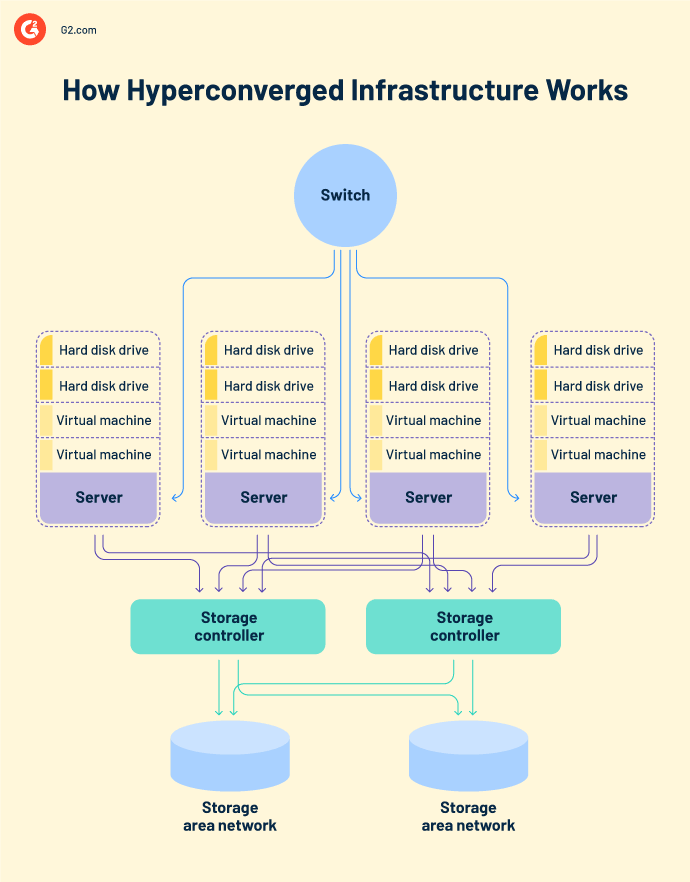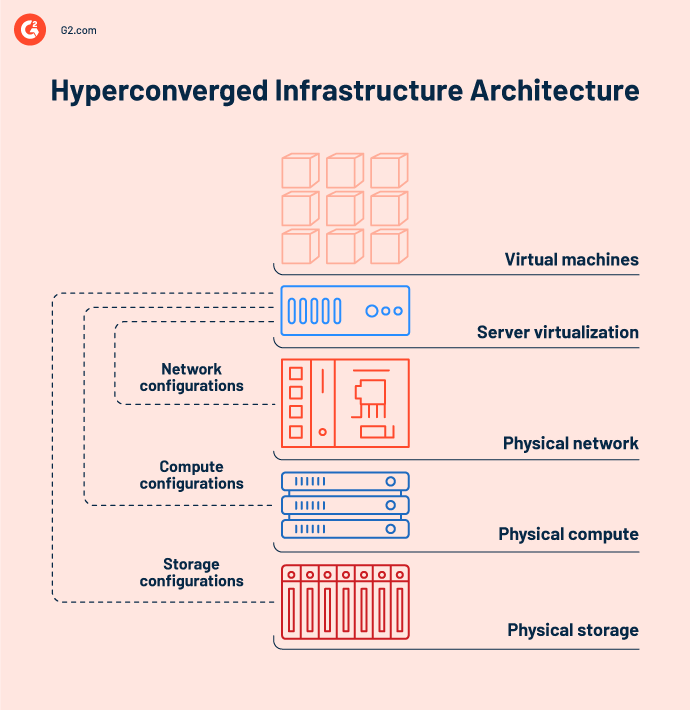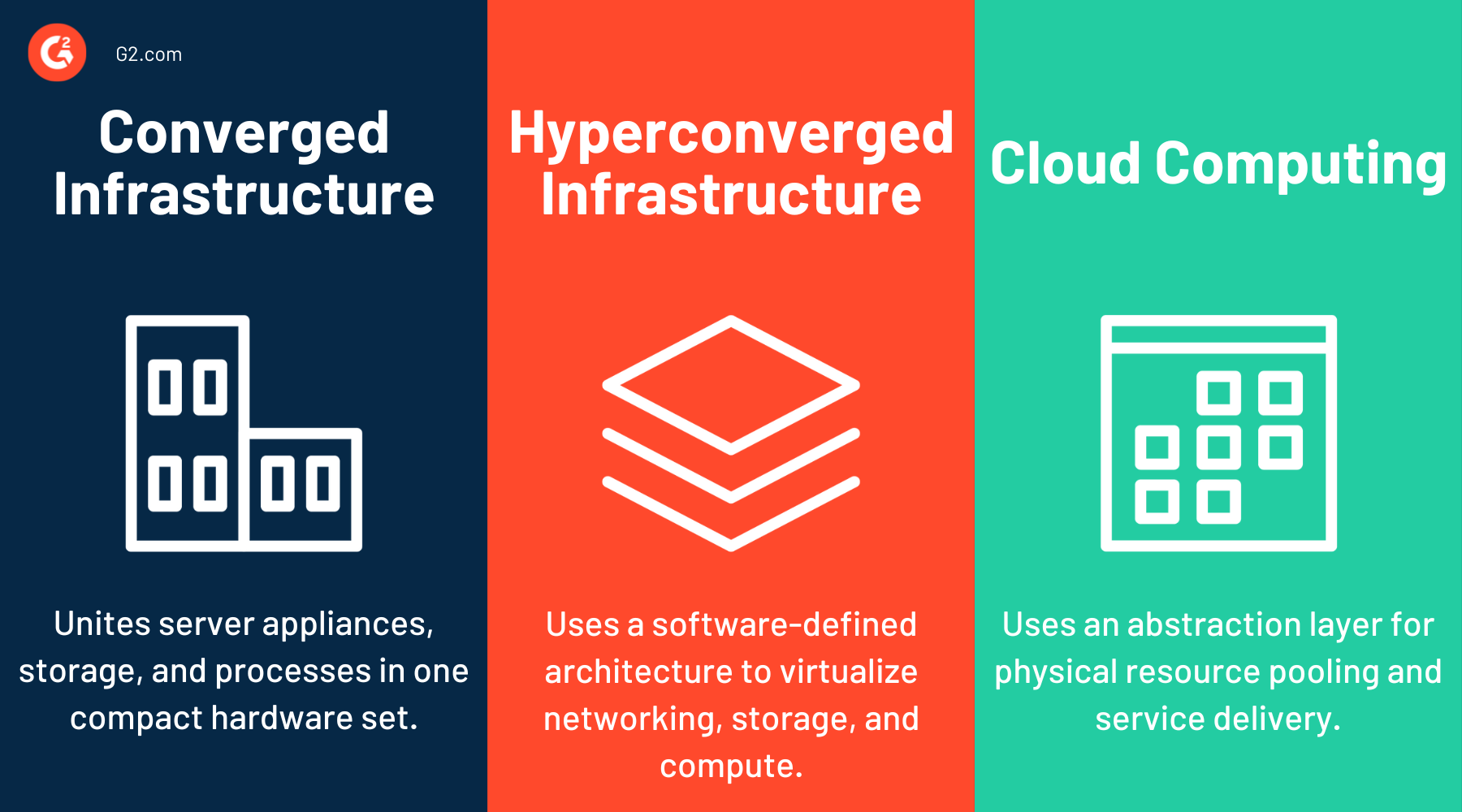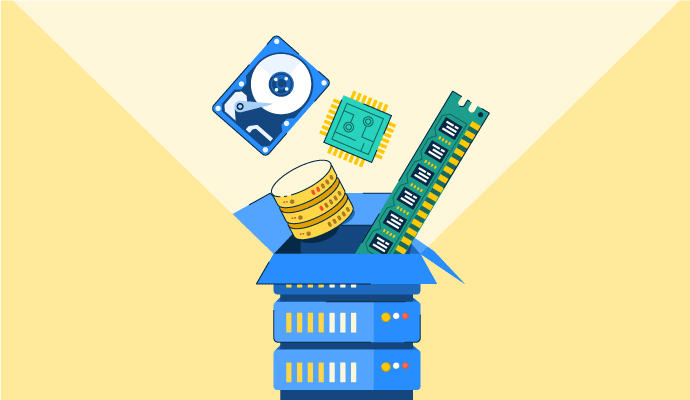What do you see when you imagine a traditional data center? Probably a tiered architecture setup: independent server, storage, management, networking, and virtualization modules. You can’t run a data center without these IT infrastructures. But data center management isn’t easy with so many building blocks. Clunky data center operation slows down cloud workload handling, which stops you from meeting business demands.
Thankfully, hyperconverged infrastructure (HCI) exists. HCI is an IT framework that unifies software-defined storage, virtualized networking, and computing to ease data center resource centralization and management. Data centers turn to HCI solutions to combine their tech stack into a single platform, minimize complexity, and boost scalability.
What is hyperconverged infrastructure?
A hyperconverged infrastructure is a software-defined architecture that integrates storage, compute, and networking virtualization into a distributed infrastructure platform for agile network management and quick network resource distribution.
Hyperconverged infrastructure virtualizes legacy storage hardware resources such as storage arrays, networks, and servers into a single system. This integration of data center server hardware and local storage devices helps automate IT provisioning and networking stack configuration.
The result is reduced dedicated storage hardware and operational cost. That’s why hyperconvergence is the first choice for bringing a cloud-like experience to on-premise systems and deploying a hybrid or private cloud.
Source: VMware Cloud Foundation
HCI lets you run software-defined storage and compute workloads together on a server. A virtualized compute and storage resource pool joins servers over Ethernet networks. These servers use virtual storage controllers to manage storage at the hypervisor or operating system layer. It can quickly scale according to your needs, which improves storage management, failover capabilities, and resiliency.
Why is hyperconverged infrastructure important?
Hyperconverged infrastructure offers a software-defined, unified environment to help you implement performance upgrades. It also eliminates the complexity and risks associated with adding new hardware or restructuring existing systems.
Today, enterprises use more data and applications than ever before. This translates to higher computing power and infrastructure support. Building these capabilities makes a data center environment complex. Traditional data center infrastructure relies on multiple administrators, teams, and systems for computer, storage, and networking component management.
For example, a storage team only works with a storage hardware vendor to maintain storage subsystems. These teams use multiple management interfaces for handling different components.
The result? Higher maintenance costs and difficulties getting support from vendors.
The complexity of managing multiple systems frustrates IT teams. They want a scalable, flexible infrastructure that instantly provisions resources and delivers faster services. That’s where hyperconverged infrastructure comes in.
Why hyperconverged infrastructure?
Enterprise companies use hyperconverged infrastructure to:
- Simplify deployments. Hyperconverged infrastructure solutions streamline the procurement-to-deployment process by letting IT teams work with a single vendor. Moreover, pre-integrated and pre-configured components eliminate traditional infrastructure acquisition, integration, and implementation costs.
- Eliminate management silos. Hyperconverged systems allow IT teams to execute administrative tasks from one platform. These systems automate load balancing and resource provisioning, along with making remote infrastructure management easy with simple point-and-click operations.
- Upgrade software and hardware faster. Thanks to HCI systems’ single-vendor delivery models and software-defined infrastructure, you no longer have to update each server architecture component separately. These systems provide unified platforms to upgrade performance with standard protocols and integrated technologies.
Quer aprender mais sobre Soluções de Infraestrutura Hiperconvergente (HCI)? Explore os produtos de Soluções de Infraestrutura Hiperconvergente (HCI).
How hyperconverged infrastructure works
An HCI solution uses a distributed software layer to converge commodity data center server hardware with locally attached storage devices like spinning disks or flash. This convergence of storage, compute, virtualization, and storage networking components in a single, pre-configured hardware box minimizes operational costs while easing infrastructure setup and maintenance.

Hyperconverged infrastructure relies on a distributed platform to replace expensive legacy infrastructure. It uses industry-standard commodity servers that feature x86 processors, solid-state drives (SSDs), and hybrid hard drives (HHDs). These servers can start small and then scale as one server at a time, as the business needs. Software tools on these servers distribute operating functions across the entire cluster (a group of nodes or servers) to improve performance and build resilience.
Hyperconverged appliances feature pre-installed virtual storage area network (SAN) controllers, which are essentially virtual machines (VMs) running on hypervisors located on servers. These virtual SAN controllers manage input/output (I/O) traffic and storage-level tasks such as:
- I/O caching
- Snapshots
- Auto-tiering
- Deduplication
- Data migration
- Erasure coding
- Thin provisioning
- Synchronous mirroring
- Asynchronous data replication
Hyperconverged infrastructure also lets you independently scale central processing units (CPUs), random access memory (RAM), and storage resources with hardware platform configurations. You can also leverage these configurations, even if you don't use a graphical processing unit (GPU) for graphics acceleration.
HCI solutions also offer a single management console that gives you a 360° view of nodes, clusters, and virtual SAN controllers. This single interface allows you to execute daily jobs without logging into multiple SAN environments.
Hyperconverged infrastructure architecture
Hyperconverged infrastructure architecture combines compute, storage, and network services in an integrated software layer.
Depending on the vendor offers, you'll find two types of hyperconvergence storage architectures – virtual storage appliance (VSA) and hypervisor-embedded storage virtualization. A typical HCI platform also uses a hardware chassis, a hypervisor, and a SAN controller.
Virtual machines run the infrastructure resource pool in a VSA-based storage model. They take the physical storage from the hypervisor and give other VMs access to that storage. VMs read and write data through virtual storage appliances that structurally live in the I/O path.
A hypervisor-level process manages the physical storage and makes it available to VMs in hypervisor-embedded storage virtualization. In this model, the hypervisor is responsible for managing storage devices.
In both cases, a hyperconverged infrastructure platform offers storage virtualization to guarantee complete control over the infrastructure stack.
Now, let’s look at each software layer in detail.
Compute virtualization creates virtual versions of computing hardware and networks. It consolidates servers which are then considered as a pool of resources by VMs. IT teams can share and access this centralized infrastructure from anywhere. As a result, they can reduce the number of physical devices behind an architecture.

Storage virtualization uses a central console to pool physical storage from multiple storage devices into a single storage device. Virtual machines rely on storage virtualization to spot and aggregate available storage capacity from physical devices.
Virtual storage solutions must be able to intercept and send incoming I/O requests from VMs to appropriate storage devices in a virtualized environment, or the whole process will fall apart. Users don't see virtual storage; to them, it just looks like a single physical drive or logical unit number (LUN) that reads and writes.
Network virtualization combines available network resources for three purposes: to aggregate physical networks into one virtual network, to connect VMs with software networks, or to divide a network into segments. It eliminates the need for network configuration before moving VMs across domains. Network administrators design isolated virtual network layers that share the same physical network fabric using network virtualization software.
Converged vs. hyperconverged infrastructure vs. cloud
Converged infrastructure (CI) is a hardware-focused, building block-based method that unites server appliances, storage, and processes in one compact hardware set. Hyperconverged infrastructure does the same thing but with a software-defined approach that simplifies IT component deployment and management from a single dashboard. Public or private cloud computing infrastructure is a single architecture that integrates physical storage, compute, and network resources.
Converged infrastructure makes data center management easier with a pre-packaged system bundle that features compute, storage, and networking components. This single system eliminates the need to purchase hardware and software components separately from different vendors. Pre-configured system elements in the bundle let you deploy infrastructure faster.

Hyperconverged infrastructure or ultra-converged infrastructure uses software-defined networking, storage, and a hypervisor to manage compute resources. The software is in charge of the resources that exist on the top of the hypervisor. This software-defined approach is flexible and supports modern workloads.
Cloud computing infrastructure relies on an abstraction layer for physical resource pooling and service delivery. Cloud eases configuration and deployment with application programming interfaces (APIs) or user interfaces. Cloud services minimize upfront infrastructure costs as they don’t need local storage to run programs or share data. But it can be complex to set up cloud infrastructure.
Hyperconvergence software vs. HCI hardware: what’s better?
Companies shopping for hyperconverged infrastructure can either choose a hardware-agnostic hyperconvergence platform or HCI hardware, also known as an integrated HCI appliance, from a single vendor. HCI software lets you bring your own technology and deploy the infrastructure. With HCI hardware, you have to buy the hardware/software package from a single vendor.
| HCI software | HCI hardware | |
| Form | Software platform | Hardware appliance |
| Function | It virtualizes hardware resources for optimal performance, storage distribution, and resilience. | It optimizes storage-to-CPU ratio based on IT infrastructure needs. |
| Benefit | HCI software offers hyperconvergence benefits on existing commodity hardware. | HCI hardware supports high-intensity IT workloads, high hardware modularity, and scalability. |
| Challenge | Existing hardware may need additional monitoring and management software for integration. | It can be pricey. Capacity addition is possible only with extra node installation. |
Plug-and-play HCI appliances have multiple benefits: minimal configuration, easy troubleshooting, and better performance optimization. Plus, you don’t need in-house storage specialists because of round-the-clock support from the vendor. However, vendor lock-in happens sometimes. You may also have to pay extra if you want to add additional network and compute resources to enhance capacity.
Unlike HCI appliances, HCI software setup is more complex and time-consuming. But you don't have to buy a new software license every time you upgrade the hardware. HCI software solutions also make it easy to add capacity according to storage needs. You have complete control over what hardware you use and how you decouple or connect software-hardware layers.
Then again, think about the time your IT team will spend tracking bugs, solving integration issues, and coordinating patches with multiple vendors. Also, keep a close eye on hardware compatibility lists (HCLs) to keep firmware versions up-to-date.
Overall, it’s wise to consider the business case and choose the suitable technology. Do your due diligence before choosing a hyperconverged infrastructure.
How to buy hyperconverged infrastructure
Ask the following questions before investing in hypercoverged infrastructure solutions.
- Can it grow and shrink capacity as you need? Do you need HCI overprovision when you need additional web servers? Or, do you have the flexibility to add cloud capacity? Answering these questions is key to understanding if you can support business peaks without service shutdown and manual migration.
- Does it support backup appliances? The flexibility of adding cloud backup as a storage tier in HCI is essential for recovery support. This backup appliance should remain visible through the network orchestration layer, which handles connections and interactions between on-premise and cloud components.
- Is it equipped to handle disaster recovery? Seamless HCI and cloud integration keep your data safe in case of disasters. Plus, replicating services in the cloud is key to reducing recovery time objective (RTO). Consider checking if the solution of your choice can automatically distribute data across nodes for safety.
- How does it ensure high performance? You won’t generally see large database servers within an HCI because these bare metal servers remove all abstraction layers and add overhead to storage access. IT teams can’t control hardware that doesn’t run the abstraction software layer. For this reason, you should check if an HCI solution allows separate storage or hardware building blocks for performance optimization.
- Does it feature additional capabilities? You may want data deduplication to save storage space or encryption capabilities to keep data secure and compliant. That’s why take time to understand what the HCI platform can do and what it can’t.
- How strong is the product support? Consider choosing HCI solutions that point you to a single vendor for hardware, hypervisor, and orchestration support. Also, be aware of how your HCI vendor tackles issues like zero-day vulnerabilities, which can put your business at risk.
- Can you update each HCI component separately? Updating all components at once may disrupt the infrastructure. Ideally, you should choose solutions that let you patch and test a portion of the infrastructure before a complete update.
Hyperconverged infrastructure use cases
Hyperconvergence adoption started with use cases like virtual desktop infrastructure (VDI) and general-purpose workloads. Today, enterprises use HCI solutions for data center consolidation, edge computing, remote office/branch office (ROBO) deployment, cloud migration, and numerous other workloads. The result is efficient IT resource deployment and management with greater capital and operating expenditure advantages.
What are the best use cases for HCI implementation?
Companies implement HCI solutions to:
- Streamline VDI deployment.
- Deploy scalable file storage structures.
- Support intense database applications.
- Connect on-premise and cloud infrastructure.
- Protect data and ensure high system availability.
- Expand capacity for write- and read-intensive apps.
- Manage general-purpose workloads, including infrastructure servers, application servers, database servers, and file servers.
VDI and desktop-as-a-service (DaaS)
VDI implementation has always troubled desktop architects and chief information officers (CIOs) because of its architectural complexity and underperforming storage. With HCI solutions, you can streamline every VDI element in one package and stay cost-efficient. So how does that work?
Virtual desktops consist of hundreds or more VMs that can get busy simultaneously. These desktops need scale-out capacity expansion to be able to add new hardware resources. Hyperconverged infrastructure solutions combine different VDI elements into a single appliance.
Each HCI host adds compute and network resources to the storage resource pool. When you have multiple HCI clusters, you don’t need different resources or new storage arrays to scale. The flexibility of adding more nodes helps you grow your DaaS business. That’s why HCI remains the first choice for diverse data workloads of the Internet of Things (IoT), files, apps, and videos.
Edge computing and ROBO model
Some companies prefer to run some things on the premises and others like the cloud better. For example, they might want to keep enterprise resource planning (ERP) systems, point-of-sale (POS) solutions, or warehouse management tools near the on-premise client workstations. They might also need robust administration capabilities if their IT department is small. Hyperconverged solutions help in creating edge environments that they can easily scale up or down.
Companies with remote offices and branch offices also use hyperconvergence to create virtualization clusters with a couple of physical servers. This means IT teams can easily manage infrastructure with a single view of all ROBO locations.
Data center consolidation
A better end user experience comes from less time spent managing infrastructure. That’s why IT operations teams prefer HCI solutions to merge servers, networking, and storage systems. Consolidating data center operations helps them improve workload capacity planning and reduce infrastructure silos.
Some companies also use HCI platforms to combine servers and redundant arrays of independent disks (RAIDs) so they can focus more on virtual machine services.
Logging and analytics
As you know, an HCI solution scales storage, RAM, and CPU at the same time. But what if a workload requires more of one resource than another? Will you end up buying unnecessary resources? Not really.
Most HCI platforms today feature storage-dense nodes, which increases storage capacity without compute and improves storage-to-compute ratio. This is why enterprises use hyperconvergence for logging and analytics as well.
Companies maintaining logs need infrastructure that supports fast writes while handling high data velocity. The underlying platform must be able to expand storage capacity quickly. Similarly, enterprises mining data for insights need an IT environment that supports fast reads to help analytics platforms generate results faster.
Both use cases require steady capacity building over time to support write- and read-intensive workloads. HCI solutions let you scale out as you grow. The total cost of ownership (TCO) is therefore lower than if you had to pay upfront for storage capacity.
Backup, disaster recovery, and data protection
Hyperconvergent environments feature data protection capabilities, too. They use VM-centric replication within an HCI cluster or from one cluster to another to backup and protect data. The scalable storage capabilities help replicate and store data in another cluster or physical location. HCI tools generally offer disaster recovery (DR) failover automation or hypervisor failover solutions.
HCI 1.0 vs. HCI 2.0: What should you choose?
HCI 1.0 bundles resources under a standard management layer, whereas HCI 2.0 improves flexibility by letting you disaggregate software from hardware resources.
First-generation hypercoverged infrastructure, aka, HCI 1.0 uses standardized nodes to integrate storage, compute, and network resources. This approach doesn’t let you upgrade components independently. You’ll always end up paying more because you have to add resources and software licenses.
Next-generation hyperconverged infrastructure or HCI 2.0 uses a composable infrastructure to put network, compute, and storage resources in a virtual resource pool. Since you can disconnect software resources from hardware, you can upgrade what you need without paying more.
Benefits of hyperconverged infrastructure
Besides offering easy infrastructure deployment, management, and upgrades, hyperconverged infrastructure solutions keep you agile, offer a cloud-like experience, and maintain low costs.
- Scale as you need. Scalability is one of the primary reasons why organizations choose HCI platforms. You can add or remove preconfigured building blocks or nodes to or from HCI clusters. These nodes make integration easier and overcome the scalability issues of traditional infrastructure.
- Keep systems reliable and available. When a node fails in an HCI platform, other nodes are ready to take over and distribute functions among themselves. You can even replace or add nodes without disruption. The software-defined environment features pre-built fault tolerance, disaster recovery, and self-healing capabilities, all key to ensuring reliability and high availability.
- Meet performance demands. HCI systems can perform varying workloads with SSDs and HDDs. There’s no need to reconfigure the hardware every time the performance requirement changes. As a bonus, you also benefit from lower latency since the storage and processing units remain in close proximity.
- Offer users a cloud-like experience. HCI platforms act like cloud solutions because they abstract and present hardware resources as consumable services. This cloud-like behavior helps you manage workloads across multiple platforms. Plus, HCI uses advanced virtualization so integrating with cloud platforms is easier.
- Minimize IT expenses. Hyperconverged infrastructure integrates commodity hardware resources, so you don’t need to spend on specialized servers, networks, or storage components. The direct-attached storage in HCI also helps you avoid SAN deployment and management costs.
Hyperconverged infrastructure challenges
Hypercoverged infrastructure isn’t free from challenges. Companies make several mistakes while sourcing, buying, and implementing HCI systems. Be careful of these common pitfalls.
- More generalists than storage specialists. It may be difficult for human resources teams in a market with an IT talent gap to hire generalists with solid knowledge of HCI components.
- Compute-to-storage ratio analysis. HCI solutions generally offer a certain amount of compute with a certain amount of storage. When you don’t think about storage needs early on, you’ll pay more as you add more nodes. You’re also going to carry additional compute.
- Understanding network demands. You’ll experience higher latency if you use poor-performing networks in hyperconvergent infrastructure. Invest in networking to ensure the proper functioning of high-performance clusters.
HCI deployment
Consider reviewing the three types of HCI deployment models below when you add hyperconverged infrastructure to a traditional data center.
- Full replacement HCI deployment replaces the entire traditional environment. Ideally, you won’t get buy-in for this option as it causes maximum hardware displacement and can be costly. This HCI deployment model suits new data center construction projects needing reference architecture.
- Side-by-side HCI deployment refers to the coexistence of a hypercovnerged cloud infrastructure and traditional heterogeneous architecture in a data center. This HCI deployment model lets you migrate workload to HCI in the long run. As a result, you can easily repurpose displaced hardware.
- Per-application HCI deployment means you use HCI to support specific applications or computing initiatives instead of migrating the workload to it. This deployment model is ideal for building a new virtual desktop infrastructure or big data processing cluster.
Hyperconverged infrastructure solutions
Hyperconverged infrastructure is the backbone of modern IT. Without the right solution, you can’t virtualize traditional hardware-defined systems. Check out the top HCI solutions in 2023 here.
To be included in this category, a software product must:
- Virtualize servers, storage, and connecting networks.
- Back up and recover virtualized data.
- Scale infrastructure per organizational needs.
- Connect with other infrastructure software and hardware.
*These top five leading hyperconverged infrastructure solutions come from G2’s Winter 2023 Grid® Report. Some reviews may be edited for clarity.
1. Nutanix Cloud Infrastructure
Nutanix Cloud Infrastructure (NCI) features built-in virtualization solutions and distributed storage fabric to consolidate workloads and achieve data locality for high performance.
What users like best:
“The simplicity and power of the product is beyond phenomenal. Everything is laid out in a foolproof manner, and regardless of how simple it looks, all of the features that are required are right in front of your face, and if you require something more advanced, it can be done from the command line interface (CLI).”
- Nutanix Cloud Infrastructure (NCI) Review, Jacob L.
What users dislike:
“It needs to improve its user interface. The initial cost may be higher than other providers. Also, I wasn’t too fond of its one-click feature to understand more about each concept.”
- Nutanix Cloud Infrastructure (NCI) Review, Sumit K.
2. StarWind Virtual SAN
StarWind Virtual SAN is a top-notch hyperconverged infrastructure solution that lets you build a fault-tolerant storage pool with mirroring between internal hard disks and hypervisor servers. You can also deploy or add it to existing IT infrastructure.
What users like best:
“It turns server disks and flash drives into a high-performance storage pool, providing scalable and cost-effective storage for virtualized environments. High availability and fault tolerance are also included with this solution. You only need 2 servers to get started, enabling you to create any type of highly available cluster you can think of that requires shared storage, be it virtualization or structured query language (SQL) server clusters.”
- StarWind Virtual SAN Review, Georgian M.
What users dislike:
“While reasonably priced, it would be nice if it was even more affordable. This day and age, every penny counts. Also, I once had to get emergency 24-hour support added on. I paid for the support (a yearly rate) but it was only good until the next renewal (just for a couple of months). That wasn't great. That kind of support should be pro-rated or permitted to carry over.”
- StarWind Virtual SAN Review, Chris T.
3. Huawei FusionCube BigData Machine
Huawei FusionCube BigData Machine offers innovative acceleration technologies to help companies build high-density data storage and connect Big Data platforms.
What users like best:
“It’s good for computation and very helpful when they provide a single package for virtualization. Deployment is faster than others.”
- Huawei FusionCube BigData Machine Review, Arpit B.
What users dislike:
“Required a lot of money to store. It isn’t useful for short runs. Sometimes data will be mismatched and unstructured.”
- Huawei FusionCube BigData Machine Review, Pradeep N.
4. VMware HCI Software
VMware HCI Software lets you converge physical storage with x86 servers for ease of scalability.
What users like best:
“It provides compute, networking structure, and storage from a single server platform which is x86. It is a sort of building block and allows datacenters with various scalability access and features.”
- VMware HCI Software Review, Anurag K.
What users dislike:
“Sometimes there was a little bit of confusion as to which computer I was controlling with my input devices.”
- VMware HCI Software Review, Ron W.
5. VxRail
VxRail by Dell simplifies IT operations management with fully preconfigured and integrated hyperconverged infrastructure appliances.
What users like best:
“It has all-flash storage, which makes it very fast and gives high input/output operations per second (IOPS) performance. It combines storage, compute, and networking into a single appliance, thus reducing overall cost and providing easy management. I’m using it with VMware, so we have all the features available in VMware. Dell's support was also good during implementation.”
- VxRail Review, Anurag P.
What users dislike:
“Lack of study material and guides to help with deployment.”
- VxRail Review, Hussein H.
Ready to transform your data center?
Data centers are growingly adopting HCI for improved security, ease of management, operational efficiency, and infrastructure consolidation. You imagined the traditional data center setup at the beginning of this article. Now, it’s your turn to adopt and transform.
Explore top data virtualization software to effortlessly store, retrieve, and integrate data with virtual data layers.

Sudipto Paul
Sudipto Paul is a Sr. Content Marketing Specialist at G2. With over five years of experience in SaaS content marketing, he creates helpful content that sparks conversations and drives actions. At G2, he writes in-depth IT infrastructure articles on topics like application server, data center management, hyperconverged infrastructure, and vector database. Sudipto received his MBA from Liverpool John Moores University. Connect with him on LinkedIn.

